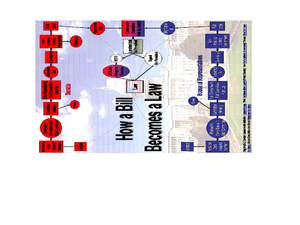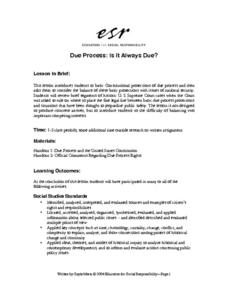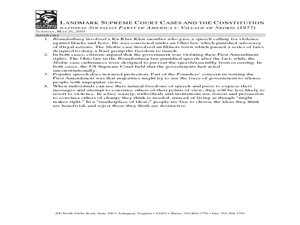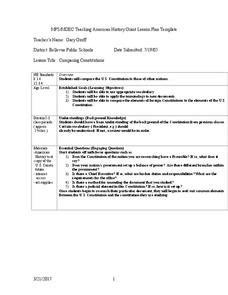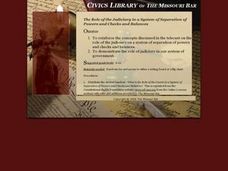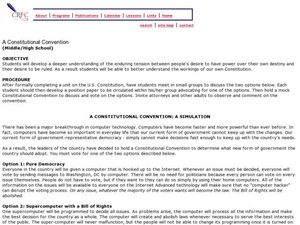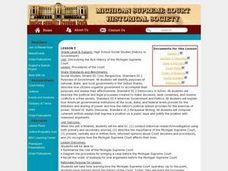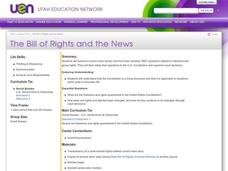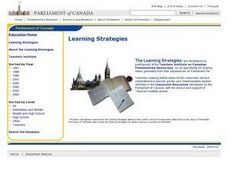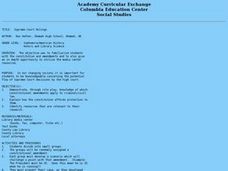Curated OER
How Government Works and the Rights of the People
Eighth graders identify how to be responsible citizens. In this civics lesson, 8th graders review websites of congressional members and then create questionnaires about the responsibilities of citizens.
Curated OER
Due Process: Is It Always Due?
Students explore the basic Constitutional protections of due process and then consider the balance of these basic protections with issues of national security. A variety of segments of U.S. Supreme Court cases are examined in this...
Curated OER
The Supreme Court
Students examine the Fourteenth Amendment. For this Supreme Court lesson, students define due process and equal protection as they analyze the impact of the amendment and the Supreme Court on workers' rights in the early 20th century....
Curated OER
FDR Tries to Pack the Supreme Court
Students analyze the Court Reform Bill of 1937. In this Supreme Court lesson plan, students listen to their instructor present a lecture regarding the details Frankin Roosevelt and his attempt to pack the Supreme Court....
Curated OER
Landmark Supreme Court Cases and the Constitution: National Socialist Party of America v. Village of Skokie (1977)
Students examine the impact of court decisions. For this Supreme Court lesson, students read the National Socialist Party of America v. Village of Skokie (1977) case study regarding First Amendment Rights. Students take notes on the case...
Curated OER
Comparing Constitutions
Students compare and contrast plans for government. In this government systems lesson, students compare and contrast the U.S. Constitution to the constitutions of selected countries using the provided checklist as a guide. Students...
Curated OER
The Formation and Function of the Supreme Court
High schoolers analyze the role of the U.S. Supreme Court. They read a handout and Article III, section 1 of the Constitution, analyze and rate by relevance noteworthy Supreme Court cases, and write how they decided each rating.
Curated OER
Constitutional Rights Of Students
Twelfth graders brief Supreme Court cases about student rights that they have studied over the past year, and apply them to a contemporary situation.
Curated OER
The Illustrated Bill of Rights
Students shoot Bill of Rights videos. In this Bill of Rights instructional activity, students film digital segment that illustrate the meaning of the first 10 amendments. Students integrate the video clips into PowerPoint presentations.
Curated OER
Government: Missouri Bar Civics Library
Students visit the Missouri bar Website to examine information about the U.S. Constitution and its Amendments. They complete a variety of activities from the provided lessons including the judiciary, Fourth Amendment issues, civil law,...
Curated OER
Making an Appeal
Young scholars make an appeal. In this making an appeal lesson students give characteristics of the Washington Supreme Court. Young scholars examine public policy conflicts and present an appellate case.
Curated OER
dsfa
Pupils work in groups examining the school's policy of no weapons on school property.
Curated OER
A CONSTITUTIONAL CONVENTION: A SIMULATION
Students discuss two computerized options to change the current U.S. government. In this Constitutional Convention lesson plan, students write a statement advocating for one of the choices and participate in a mock modern Constitutional...
Curated OER
Procedures of the Court
Students examine the role of the Michigan Supreme Court. They diagram the procedure one must follow to bring a case before the Court. They discuss the order of business for oral arguments as well.
Curated OER
The Bill of Rights and the News
Young scholars examine current news stories and from them develop "BIG" questions related to individual and group rights. They then relate their questions to the U.S. Constitution and supreme court decisions.
Curated OER
Supreme Court Newspaper
Students examine the purpose and responsibilities of the Supreme Court and its justices. In groups, they research a specific case and identify how the Supreme Court affects their lives. Using the information they find, they create a...
Curated OER
Scavenger Hunt
Middle schoolers participate in a scavenger hunt to gather information on their governmental officials. Using the internet, they identify and discuss the various political boundaries to determine who their representative is. They...
Curated OER
John G. Roberts, Jr. -- Nominee, Chief Justice of the U.S. Supreme Court
Young scholars examine the life and work of John G. Roberts, the nominee to be the Chief Justice of the Supreme Court. In groups, they use the internet to define the role of the Chief Justice and complete handouts to record their...
Curated OER
What Do You Know? Supreme Court Nominations
Learners discuss what they believe Supreme Court Justices should do while in office. As a class, they brainstorm a list of their prior knowledge about the justices and Supreme Court. In their journal, they write about the qualities of...
Curated OER
Faces of the Bench
High schoolers use primary source documents to gather information on justices in the Michigan Supreme Court. They write about the thoughts and experiences of the author. They identify and describe each justice briefly.
Curated OER
The "Big Four" of the Michigan Supreme Court
Students identify the justices on the Michigan Supreme Court known as the "Big Four". They relate to them by researching their lives. They participate in an activity in which they practice their investigation and presentation skills.
Curated OER
Vocabulary Related to the Attire, Accessories and Décor of the Parliament of Canada
Students become knowledgable about the attire, traditions, and protocols of the Senate and Supreme Court by doing research.
Curated OER
Supreme Court Rulings
Become familiar with the constitution and amendments with an in depth opportunity to utilize media center resources. Groups of students focus on an amendment then make a presentation to the class.
Curated OER
In the Light of Reverence
Students watch a documentary prior to participating in a Supreme Court simulation in order to study how religious practices are protected by the First Amendment of the Constitution. They interpret conflict from a number of perspectives...
